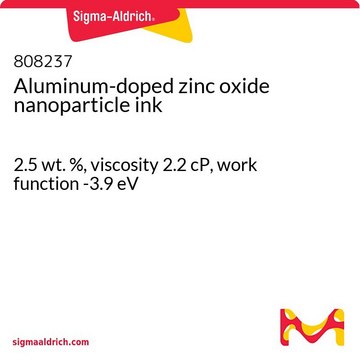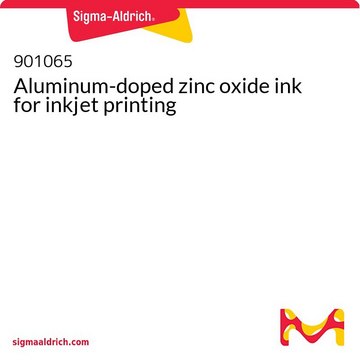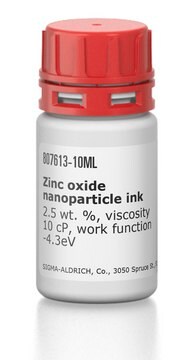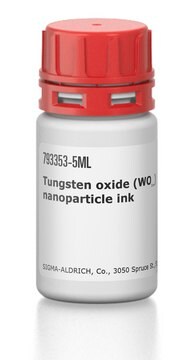807729
Aluminum-doped zinc oxide nanoparticle ink
2.5 wt. %, viscosity 2.5 cP, work function -4.3eV
Synonym(e):
AZO ink, Al-doped ZnO dispersion, Al-dopend ZnO suspension, Al:ZnO ink, Avantama N-20X, Nanograde N-20X
About This Item
Empfohlene Produkte
Form
dispersion
Konzentration
2.5 wt. % (crystalline Al doped ZnO (3.15 mol% Al) in 2-propanol)
Arbeitsfunktion
-4.1--4.5 eV
Partikelgröße
8-16 nm
Viskosität
1.9-3.1 cP
Suchen Sie nach ähnlichen Produkten? Aufrufen Leitfaden zum Produktvergleich
Anwendung
Angaben zur Herstellung
- Storage: In dark at room temperature.
- Prior to application: Shake, ultrasonicate with sonic horn and (optionally) filter through 0.45μm PTFE filter.
- Post-treatment: Annealing of deposited Al doped ZnO films at 80°C - 120°C.
Rechtliche Hinweise
Signalwort
Danger
H-Sätze
Gefahreneinstufungen
Aquatic Chronic 2 - Eye Irrit. 2 - Flam. Liq. 2 - STOT SE 3
Zielorgane
Central nervous system
Lagerklassenschlüssel
3 - Flammable liquids
WGK
WGK 2
Flammpunkt (°F)
53.6 °F
Flammpunkt (°C)
12 °C
Hier finden Sie alle aktuellen Versionen:
Analysenzertifikate (COA)
Die passende Version wird nicht angezeigt?
Wenn Sie eine bestimmte Version benötigen, können Sie anhand der Lot- oder Chargennummer nach einem spezifischen Zertifikat suchen.
Besitzen Sie dieses Produkt bereits?
In der Dokumentenbibliothek finden Sie die Dokumentation zu den Produkten, die Sie kürzlich erworben haben.
Artikel
Professor Tokito and Professor Takeda share their new materials, device architecture design principles, and performance optimization protocols for printed and solution-processed, low-cost, highly flexible, organic electronic devices.
Recent progress in the area of solution-processed functional materials has led to the development of a variety of thin-film optoelectronic devices with significant promise in the industrial and consumer electronics fields.
Unser Team von Wissenschaftlern verfügt über Erfahrung in allen Forschungsbereichen einschließlich Life Science, Materialwissenschaften, chemischer Synthese, Chromatographie, Analytik und vielen mehr..
Setzen Sie sich mit dem technischen Dienst in Verbindung.










